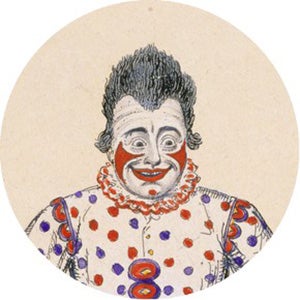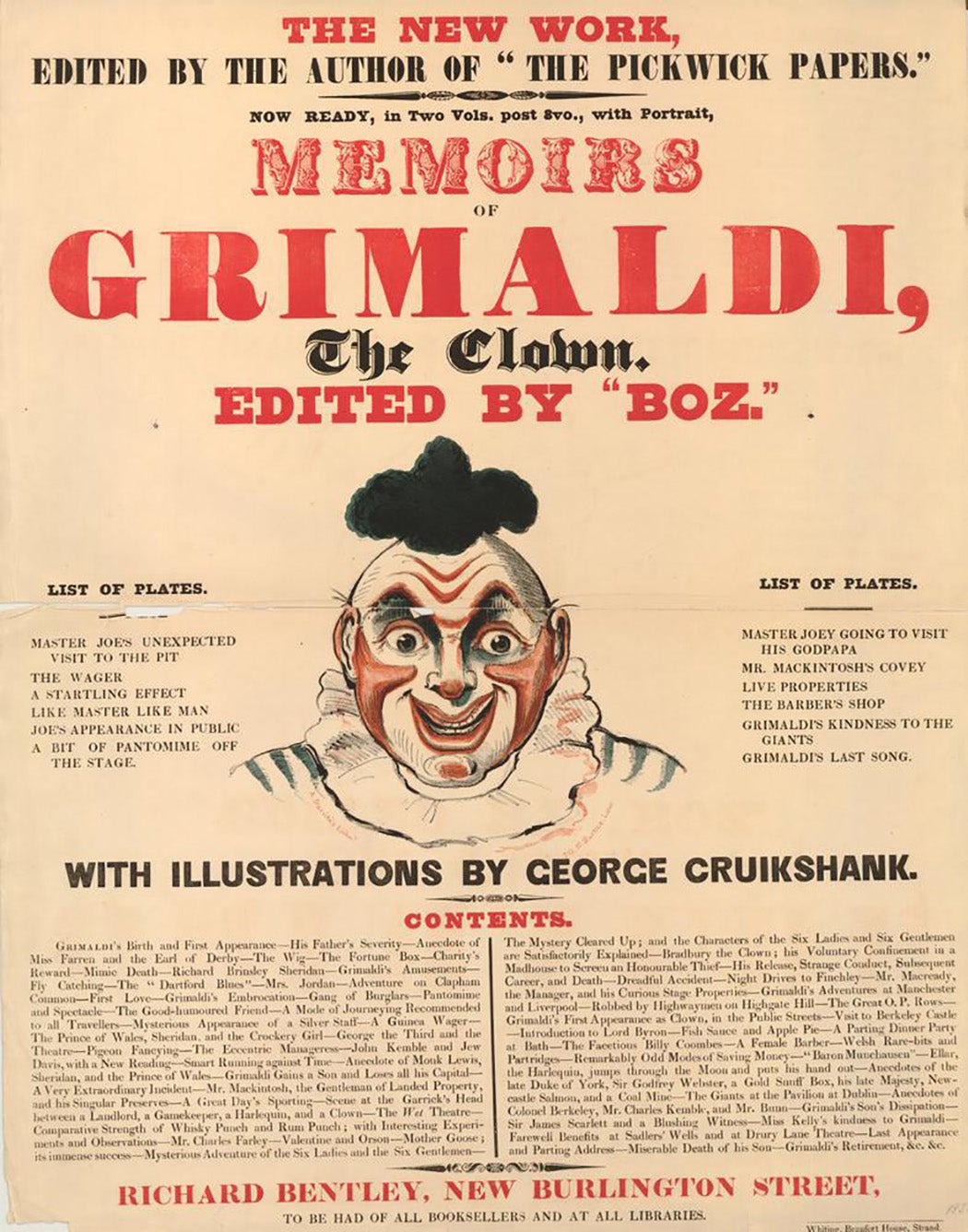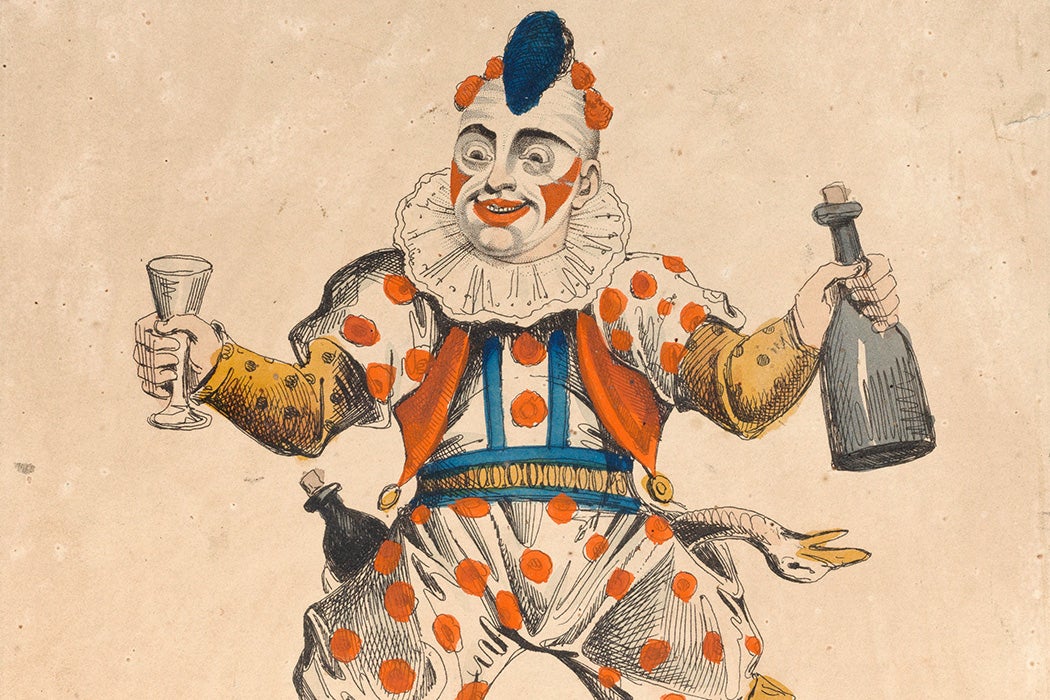Not far from King’s Cross rail station, in a quiet residential area, there is a pleasant patch of green that is more park than graveyard. Shaded by lime trees and horse chestnut, the place has a perennial gloomy caste. Its dark aura deters neither workers nor university students who steal a few minutes for a sandwich or tea in this burial ground for parishioners from St. James Anglican Chapel. Few pause to consider the site’s new designation—Joseph Grimaldi Park, named for London’s most beloved actor of the 19th century. He is also interred there, though likely few people passing through have any idea who he was. Yet in his day, no comedic performer drew bigger audiences and louder laughs than Grimaldi. He did nothing short of invent our most disquieting performance archetype: the clown.
Clowning was Grimaldi’s birthright. His great-grandfather was an amateur performer who had moved his family from Italy in 1730, bringing with him the commedia dell’arte tradition popular from the 16th through the 18th centuries. Its improvised sketches revolved around stock characters: wealthy old men known as vecchi; innamorti, beautiful, wealthy lovers; braggards designated il capitano; and knave-ish servants, or zanni (hence the adjective zany). For centuries, characters like the beautiful young maid Colombina or the foolish old Pulcinella functioned like melodies upon which individual performers riffed.
Weekly Newsletter
As commedia dell’arte moved throughout Europe, the “clown” became a hayseed bumpkin confused by city life; he stood in contrast with the urbane zanni, whose proper name was “Harlequin.” Clowns wore shoddy clothes and naturalistic makeup and were a character type that Grimaldi knew well with when he started getting attention for his work when he was still just a toddler. What Grimaldi ultimately did with that character changed clowning forever, replacing the naturalist look with the grotesque.
In 1801, Grimaldi first appeared at Sadler’s Wells Theater with smears of conspicuous make-up and dressed in bizarre clothing. With this costume, he established the clown as a strange archetypal nightmare. It was “unsettling because it superimposed childlike… body adornment over a distinctly adult… body,” writes Sarah M. Gordon in The Journal of American Folklore. This move belied the “question of why adults would willingly infantilize themselves and dress in such peculiar clothing,” writes Andrew McConnell Stott in the Journal for Early Modern Cultural Studies. From the knickers to the slippers, Grimaldi’s outfit evoked the uniforms of school boys in the era of King George; his spangled, flamboyant colors competed with the Harlequins for visual pop.

Even more shocking was the entirely white-makeup covering every bit of visible flesh, including ears, lips, and nostrils. In an illustration by George Cruikshank, the 19th century British caricaturist, Grimaldi has thick white greasepaint smeared across his face; an elongated crimson chevron painted on each cheek and garish red lipstick gives his mouth an obscene caste. His curly black mane is styled into a bouffant that recedes beyond his hairline, and he wears colorful knickered pantaloons and a ruffled collar. The look, Gordon says, drew on the anarchic and was used to create anarchy on stage.
There, Grimaldi was heralded for his acrobatic prowess, as well as for prodigious and repulsive acts of eating, strange contortions, and bizarre facial expressions. He invoked catchphrases such as “Here we are again!” and the slightly demonic “Shall I?” which he would ask the audience before embarking on new mischief. Neither boy nor Harlequin, Grimaldi’s clown was something entirely different—a “temporally nonspecific man-child,” says Stott, with a nickname of ‘Joey’ under which he was “literally subsumed.”
This new form of clowning caught on fast. “Grimaldi is the principal because of our crowded lobbies and scarcely standing room,” wrote a reporter in 1807 in the Monthly Mirror, a year after he starred in Thomas John Dibdin’s Harlequin and Mother Goose; or the Golden Egg. Less than two decades later, in 1823, a writer for the Times said, “Grimaldi belongs to Covent-Garden theater as completely as St. Paul’s belongs to Ludgate-hill.” He was hugely popular: roughly an eighth of the theater-goers in London regularly saw Grimaldi perform, according to Andrew McConnell Stott.
Throughout his three-decade career, Grimaldi appeared regularly at the Drury Lane Theater and Covent-Garden Theater in pantomimes including Peter Wilkins: or Harlequin in the Flying World and Harlequin and Fortunio; or Shing-Moo and Thun-Ton. Devoid of speaking but for songs and catchphrases, pantomime depended entirely on an actor’s physicality. In theater, it bears more similarity to the circus than Shakespeare (jesters and fools notwithstanding). And yet, observed a writer in the Monthly Mirror in 1807, “Many of our second and third-rate tragedians would give their ears to meet with half the plaudits which are every night conferred on Grimaldi for his inimitable exertions. He has arrived at an acme of all clownery.” Even Lord Byron was a fan; Grimaldi would leave tickets for him at the box office.
Grimaldi is every bit the archetypal clown—but he was also the first modern clown.
As strange as Grimaldi’s style of performance seems to us today, there is a reason why his genius was celebrated during the Regency. In that era, pantomime was the most popular genre in Britain owing both to cultural tradition and legal prohibition against dialogue. During the Regency era, spoken dialogue was permitted on just three London stages and a stationer’s register—a government censor who approved copyrights—carefully parsed any scripts. Elsewhere, pantomime ruled the day. It was a unique “mixture of nursery rhyme and fairy tale” writes Kaplan in the Antioch Review, featuring “sentimental ballads, topical and often satirical references, elaborate stage sets, patriotic songs and tableaux, leggy young women playing juvenile leads, and male comics playing old ladies, all in plots that display a surreal disregard of logic.” Derived in part from commedia dell’arte and indigenous jester forms, pantomime was distinctly its own thing and offered a means of expression free of government censors. Pantomime had a “alluring radicalism,” says Jonathan Buckmaster in Dickens’s Clowns: Charles Dickens, Joseph Grimaldi, and the Pantomime of Life, that “utilized this liminal legal status to present material which subversively ridiculed authority figures and deflated the pretense of social and official rituals.”
If any genre bears any similarity to pantomime, it’s silent film, though the reason for the silence was purely technological. What these genres share is a dependence on physicality, not words, to communicate.
Pantomime relied on actors’ athletic acumen, and in that regard Grimaldi was unparalleled. Persia’s ambassador to the Court of St. James attended a show in 1811, and later gushed that Grimaldi “would leap from a high window and just as easily leap back up again, returning each time as a different character.” In the Irish Monthly Gabriel Fallon quoted a contemporary who observed how the clown’s eyes, “large, globular and sparkling, rolled in a riot of joy. His mouth… as if endowed with a never ending power of extension, seemed fitted to express every physical enjoyment or disgust… disdain, anger, fear or joy worked in his grinning countenance.” New Monthly Magazine concluded that “speech would have been thrown away in his performance… Every limb of him had a language.”
Grimaldi belongs in the pantheon of physical comedians alongside Charlie Chaplin and Buster Keaton. Yet like silent film, pantomime also had an expiration date. By 1843 the legal strictures on spoken dialogue in unregistered plays was be repealed, long after Grimaldi’s retirement and six years after his dissolute death, making pantomime itself largely superfluous. The fortunes of the art form which Grimaldi exulted took the same downward trajectory as the clown’s own life. Son of an abusive drunken bigamist who squandered the family’s money and father of an alcoholic clown who never lived up to Grimaldi’s promise, he drank himself to death in 1837.
Grimaldi’s behavior in his final days morphed him in the public eye into another type: the sad clown. He lived in hovels and attempted a mutual suicide with his second wife. The public’s knowledge of Grimaldi’s transformation from “Joey,” the acrobatic, white-caked and grotesque-mouthed trickster to this woeful creature demonstrated precisely how humor and tragedy intertwined. The clown himself joked about his struggles. “I am GRIM ALL DAY, but I make you laugh at night,” he punned.

Memoirs of Joseph Grimaldi, published a year after his death, is central to the myth of the sad clown. Based on his notes, the book was organized, edited, and in some cases ghost-written by Charles Dickens, then 25, who was hired by a Grub Street publisher. In an essay in Biography, Leigh Woods argues that “Dickens generated repeatedly in his own narrative images… a sharp disparity between the performer’s private experience and his public perception of that experience as it unfolded on the stage.”
Though Dickens advocated for reforming theater districts with a more morally edifying variety of performance, Grimaldi was a figure whom he was drawn toward, having attended a Christmas pantomime as a young boy. Attracted to the romance of a master artist whose life dwindles along with his form’s extinction, Dickens’ Memoirs of Joseph Grimaldi is full of pathos, where as Wood writes, the “performer’s suffering is somehow proportional to his audience’s appreciations of his performance.” Dickens admits as much, writing that “throughout the whole of Grimaldi’s existence, which was a checkered one enough, there always seemed some odd connection between his good and bad fortune.” Readers of the memoir are confronted with a Grimaldi so exhausted by his performances, he was unable to stand after they were over. He would stagger into a “small room behind the prompter’s box, and there sinking into an arm-chair, give full vent to the emotions which he found it impossible to suppress.”

Dickens’ Grimaldi (and perhaps the real one too) was a man who transformed himself into a clown because of his psychological constipation. He was a bifurcated personality apt to “chalking over the seams which mental agony had worn in his face.” The Memoirs of Joseph Grimaldi is a trauma narrative. It offers a a horrifying portrait of the abuse Grimaldi endured at the hands of his father; when the two performed together the father “fell upon his son at once, and beat him severely,” writes Dickens. “This was all taken by the audience as a most capital joke” and “the papers the next morning declared that it was perfectly wonderful to see a mere child perform so naturally.” A haunted man, Grimaldi would “sob and cry aloud, and suffer so much violent and agonizing spasms” his fellow actors feared he’d be unable to return for the second act. Yet return he did, always ready to “rally at the necessary time.”
In his own 1887 memoir, theater critic Thomas Goodwin recounted how Grimaldi visited a famed surgeon to find a cure for his melancholy. The doctor suggested he pursue “relaxation and amusement… perhaps sometimes at the theater;—go and see Grimaldi.’ ‘Alas!’ replied the patient, ‘that is of no avail to me; I am Grimaldi.’”
Grimaldi used his depression to artistic effect, as he also did with the uncanniness of his appearance. Creepiness wasn’t inadvertent in Grimaldi’s creation. The “combined themes of division, concealment, and deterioration clearly provide the basic components for the sinister clowns that stalk us in the present day,” writes Stott, while Gordon credits Dickens with crafting the creepy clown archetype. More than that, Dickens identified and communicated something sinister that had already been conceived by Grimaldi.
A year before the Memoirs of Joseph Grimaldi, Dickens gave visceral description to his own coulrophobia in The Pickwick Papers when a character encounters a “repulsive sight,” an actor dressed in all the “absurdity of a clown’s costume.” In the last year of Grimaldi’s life, Dickens described a dying clown with “bloated body and shrunken legs… glassy eyes, contrasting fearfully with the thick white paint with which the face was besmeared: the grotesquely ornamented head, trembling with paralysis, and the long skinny hands, rubbed with white chalk.”
Clowns are creatures of modernity, there is an absurdity and horror to their alienation. Grimaldi’s genius was to create this ostensibly comic figure who had a “hideous and unnatural appearance of which no description could convey an adequate idea,” as Dickens writes. If a clown had once been a visual representation of a cornpone yokel trying to make it in the big city, Grimaldi pushed the grotesquerie to the limits of representation itself. A clown isn’t anything other than a clown; he doesn’t symbolize, or represent, or mean anything—that’s why he’s terrifying. A clown is a stand-in for all of us in our naked humanity.







